Impact of Child Hospitalization: A Case Study on Drawings and Nursing
VerifiedAdded on 2021/04/21
|10
|3025
|472
Case Study
AI Summary
This case study examines the impact of child hospitalization on children and their families. It explores how nurses can use children's drawings as a therapeutic tool to understand their feelings and anxieties. The study analyzes a drawing by a 6-year-old female, interpreting it through psychosocial and cognitive developmental theories. It discusses the emotional, social, and financial implications of hospitalization on families, identifying nursing strategies such as promoting calmness, effective communication, distraction techniques, and educational support to alleviate negative effects. The paper emphasizes the importance of providing physical comfort, offering treats, and playing music to reduce children's anxiety and enhance their overall well-being during hospitalization. The case study highlights the multifaceted challenges and offers practical solutions to support both children and their families through this difficult experience.

UNIT:
NAME:
DATE:
NAME:
DATE:
Paraphrase This Document
Need a fresh take? Get an instant paraphrase of this document with our AI Paraphraser
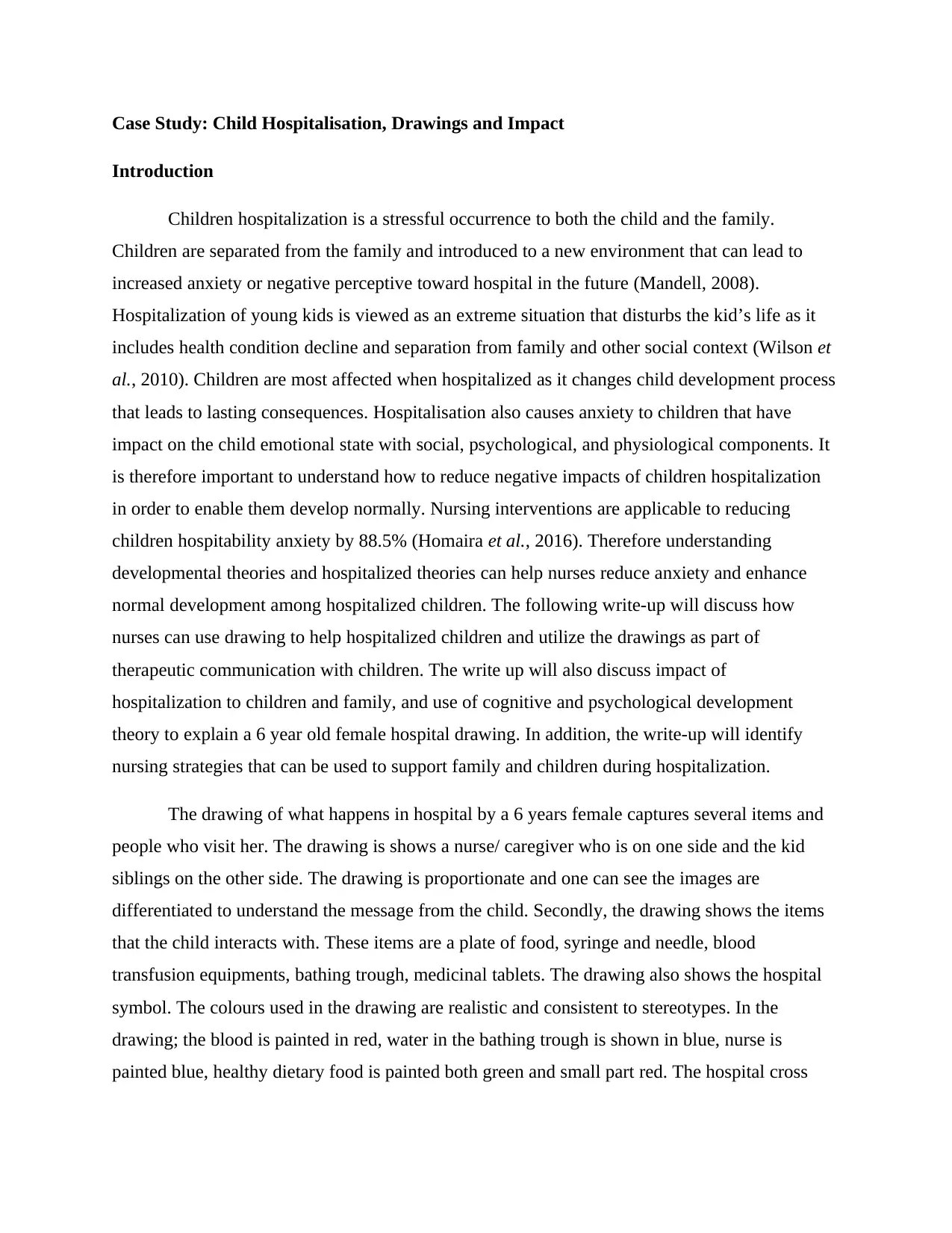
Case Study: Child Hospitalisation, Drawings and Impact
Introduction
Children hospitalization is a stressful occurrence to both the child and the family.
Children are separated from the family and introduced to a new environment that can lead to
increased anxiety or negative perceptive toward hospital in the future (Mandell, 2008).
Hospitalization of young kids is viewed as an extreme situation that disturbs the kid’s life as it
includes health condition decline and separation from family and other social context (Wilson et
al., 2010). Children are most affected when hospitalized as it changes child development process
that leads to lasting consequences. Hospitalisation also causes anxiety to children that have
impact on the child emotional state with social, psychological, and physiological components. It
is therefore important to understand how to reduce negative impacts of children hospitalization
in order to enable them develop normally. Nursing interventions are applicable to reducing
children hospitability anxiety by 88.5% (Homaira et al., 2016). Therefore understanding
developmental theories and hospitalized theories can help nurses reduce anxiety and enhance
normal development among hospitalized children. The following write-up will discuss how
nurses can use drawing to help hospitalized children and utilize the drawings as part of
therapeutic communication with children. The write up will also discuss impact of
hospitalization to children and family, and use of cognitive and psychological development
theory to explain a 6 year old female hospital drawing. In addition, the write-up will identify
nursing strategies that can be used to support family and children during hospitalization.
The drawing of what happens in hospital by a 6 years female captures several items and
people who visit her. The drawing is shows a nurse/ caregiver who is on one side and the kid
siblings on the other side. The drawing is proportionate and one can see the images are
differentiated to understand the message from the child. Secondly, the drawing shows the items
that the child interacts with. These items are a plate of food, syringe and needle, blood
transfusion equipments, bathing trough, medicinal tablets. The drawing also shows the hospital
symbol. The colours used in the drawing are realistic and consistent to stereotypes. In the
drawing; the blood is painted in red, water in the bathing trough is shown in blue, nurse is
painted blue, healthy dietary food is painted both green and small part red. The hospital cross
Introduction
Children hospitalization is a stressful occurrence to both the child and the family.
Children are separated from the family and introduced to a new environment that can lead to
increased anxiety or negative perceptive toward hospital in the future (Mandell, 2008).
Hospitalization of young kids is viewed as an extreme situation that disturbs the kid’s life as it
includes health condition decline and separation from family and other social context (Wilson et
al., 2010). Children are most affected when hospitalized as it changes child development process
that leads to lasting consequences. Hospitalisation also causes anxiety to children that have
impact on the child emotional state with social, psychological, and physiological components. It
is therefore important to understand how to reduce negative impacts of children hospitalization
in order to enable them develop normally. Nursing interventions are applicable to reducing
children hospitability anxiety by 88.5% (Homaira et al., 2016). Therefore understanding
developmental theories and hospitalized theories can help nurses reduce anxiety and enhance
normal development among hospitalized children. The following write-up will discuss how
nurses can use drawing to help hospitalized children and utilize the drawings as part of
therapeutic communication with children. The write up will also discuss impact of
hospitalization to children and family, and use of cognitive and psychological development
theory to explain a 6 year old female hospital drawing. In addition, the write-up will identify
nursing strategies that can be used to support family and children during hospitalization.
The drawing of what happens in hospital by a 6 years female captures several items and
people who visit her. The drawing is shows a nurse/ caregiver who is on one side and the kid
siblings on the other side. The drawing is proportionate and one can see the images are
differentiated to understand the message from the child. Secondly, the drawing shows the items
that the child interacts with. These items are a plate of food, syringe and needle, blood
transfusion equipments, bathing trough, medicinal tablets. The drawing also shows the hospital
symbol. The colours used in the drawing are realistic and consistent to stereotypes. In the
drawing; the blood is painted in red, water in the bathing trough is shown in blue, nurse is
painted blue, healthy dietary food is painted both green and small part red. The hospital cross
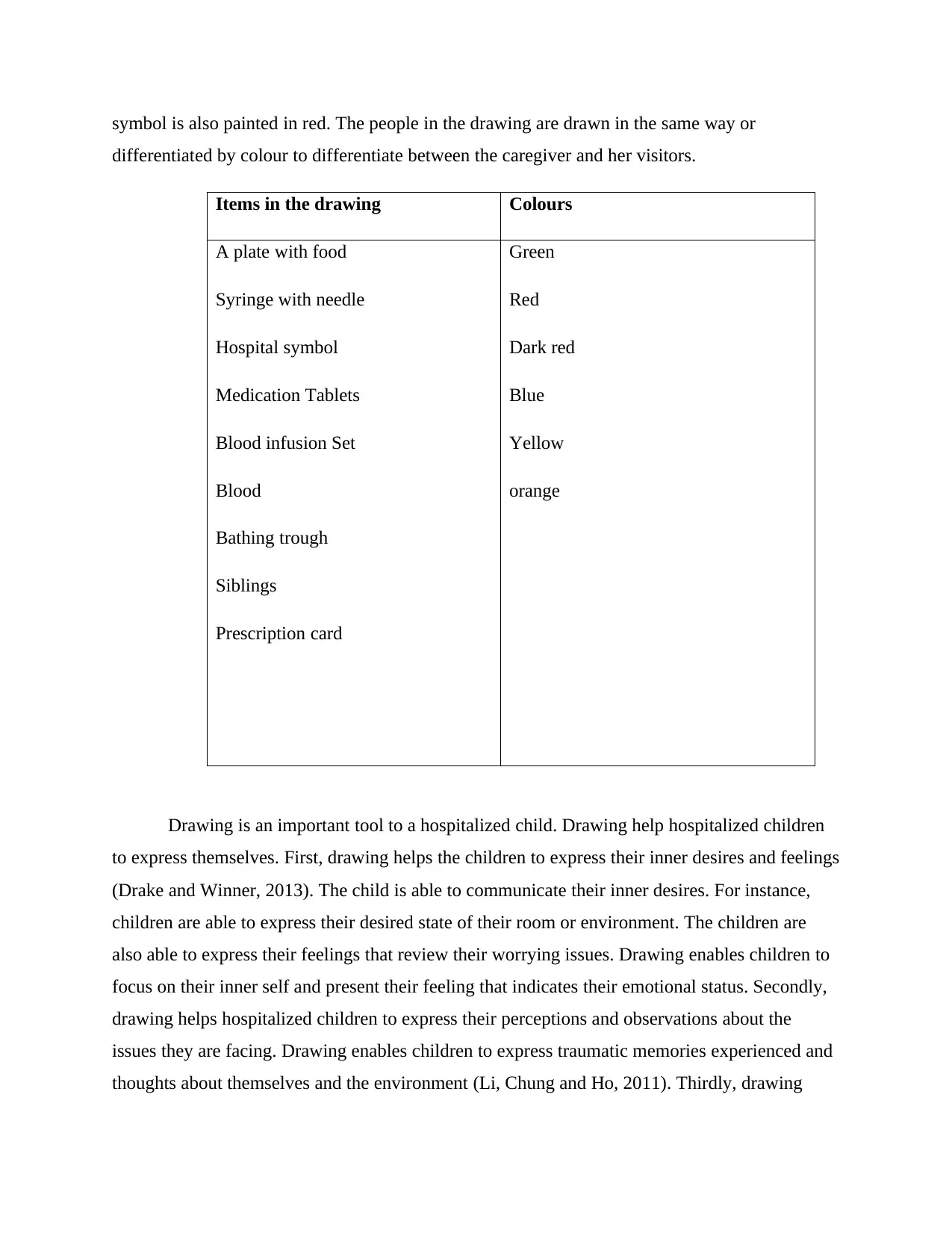
symbol is also painted in red. The people in the drawing are drawn in the same way or
differentiated by colour to differentiate between the caregiver and her visitors.
Items in the drawing Colours
A plate with food
Syringe with needle
Hospital symbol
Medication Tablets
Blood infusion Set
Blood
Bathing trough
Siblings
Prescription card
Green
Red
Dark red
Blue
Yellow
orange
Drawing is an important tool to a hospitalized child. Drawing help hospitalized children
to express themselves. First, drawing helps the children to express their inner desires and feelings
(Drake and Winner, 2013). The child is able to communicate their inner desires. For instance,
children are able to express their desired state of their room or environment. The children are
also able to express their feelings that review their worrying issues. Drawing enables children to
focus on their inner self and present their feeling that indicates their emotional status. Secondly,
drawing helps hospitalized children to express their perceptions and observations about the
issues they are facing. Drawing enables children to express traumatic memories experienced and
thoughts about themselves and the environment (Li, Chung and Ho, 2011). Thirdly, drawing
differentiated by colour to differentiate between the caregiver and her visitors.
Items in the drawing Colours
A plate with food
Syringe with needle
Hospital symbol
Medication Tablets
Blood infusion Set
Blood
Bathing trough
Siblings
Prescription card
Green
Red
Dark red
Blue
Yellow
orange
Drawing is an important tool to a hospitalized child. Drawing help hospitalized children
to express themselves. First, drawing helps the children to express their inner desires and feelings
(Drake and Winner, 2013). The child is able to communicate their inner desires. For instance,
children are able to express their desired state of their room or environment. The children are
also able to express their feelings that review their worrying issues. Drawing enables children to
focus on their inner self and present their feeling that indicates their emotional status. Secondly,
drawing helps hospitalized children to express their perceptions and observations about the
issues they are facing. Drawing enables children to express traumatic memories experienced and
thoughts about themselves and the environment (Li, Chung and Ho, 2011). Thirdly, drawing
⊘ This is a preview!⊘
Do you want full access?
Subscribe today to unlock all pages.

Trusted by 1+ million students worldwide
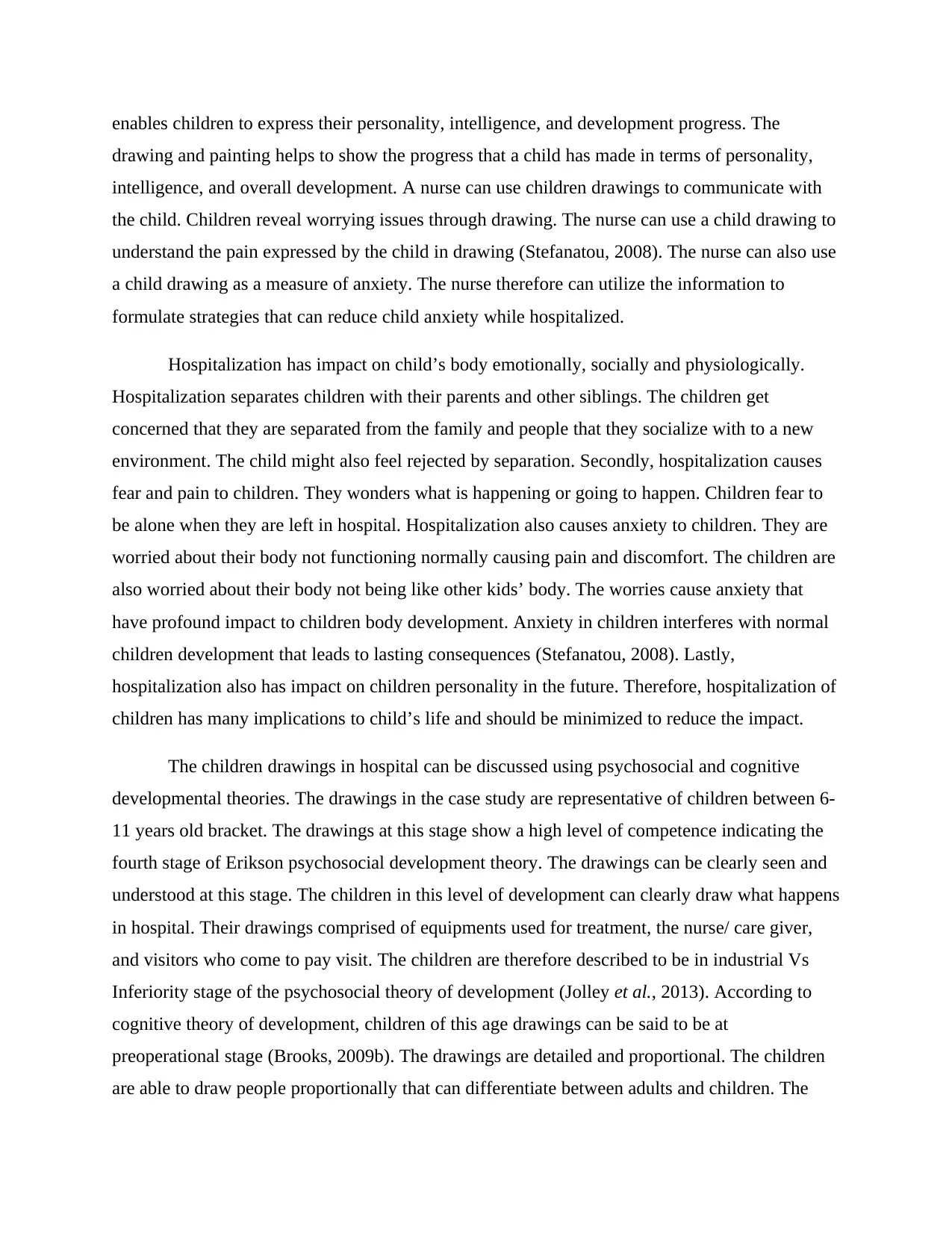
enables children to express their personality, intelligence, and development progress. The
drawing and painting helps to show the progress that a child has made in terms of personality,
intelligence, and overall development. A nurse can use children drawings to communicate with
the child. Children reveal worrying issues through drawing. The nurse can use a child drawing to
understand the pain expressed by the child in drawing (Stefanatou, 2008). The nurse can also use
a child drawing as a measure of anxiety. The nurse therefore can utilize the information to
formulate strategies that can reduce child anxiety while hospitalized.
Hospitalization has impact on child’s body emotionally, socially and physiologically.
Hospitalization separates children with their parents and other siblings. The children get
concerned that they are separated from the family and people that they socialize with to a new
environment. The child might also feel rejected by separation. Secondly, hospitalization causes
fear and pain to children. They wonders what is happening or going to happen. Children fear to
be alone when they are left in hospital. Hospitalization also causes anxiety to children. They are
worried about their body not functioning normally causing pain and discomfort. The children are
also worried about their body not being like other kids’ body. The worries cause anxiety that
have profound impact to children body development. Anxiety in children interferes with normal
children development that leads to lasting consequences (Stefanatou, 2008). Lastly,
hospitalization also has impact on children personality in the future. Therefore, hospitalization of
children has many implications to child’s life and should be minimized to reduce the impact.
The children drawings in hospital can be discussed using psychosocial and cognitive
developmental theories. The drawings in the case study are representative of children between 6-
11 years old bracket. The drawings at this stage show a high level of competence indicating the
fourth stage of Erikson psychosocial development theory. The drawings can be clearly seen and
understood at this stage. The children in this level of development can clearly draw what happens
in hospital. Their drawings comprised of equipments used for treatment, the nurse/ care giver,
and visitors who come to pay visit. The children are therefore described to be in industrial Vs
Inferiority stage of the psychosocial theory of development (Jolley et al., 2013). According to
cognitive theory of development, children of this age drawings can be said to be at
preoperational stage (Brooks, 2009b). The drawings are detailed and proportional. The children
are able to draw people proportionally that can differentiate between adults and children. The
drawing and painting helps to show the progress that a child has made in terms of personality,
intelligence, and overall development. A nurse can use children drawings to communicate with
the child. Children reveal worrying issues through drawing. The nurse can use a child drawing to
understand the pain expressed by the child in drawing (Stefanatou, 2008). The nurse can also use
a child drawing as a measure of anxiety. The nurse therefore can utilize the information to
formulate strategies that can reduce child anxiety while hospitalized.
Hospitalization has impact on child’s body emotionally, socially and physiologically.
Hospitalization separates children with their parents and other siblings. The children get
concerned that they are separated from the family and people that they socialize with to a new
environment. The child might also feel rejected by separation. Secondly, hospitalization causes
fear and pain to children. They wonders what is happening or going to happen. Children fear to
be alone when they are left in hospital. Hospitalization also causes anxiety to children. They are
worried about their body not functioning normally causing pain and discomfort. The children are
also worried about their body not being like other kids’ body. The worries cause anxiety that
have profound impact to children body development. Anxiety in children interferes with normal
children development that leads to lasting consequences (Stefanatou, 2008). Lastly,
hospitalization also has impact on children personality in the future. Therefore, hospitalization of
children has many implications to child’s life and should be minimized to reduce the impact.
The children drawings in hospital can be discussed using psychosocial and cognitive
developmental theories. The drawings in the case study are representative of children between 6-
11 years old bracket. The drawings at this stage show a high level of competence indicating the
fourth stage of Erikson psychosocial development theory. The drawings can be clearly seen and
understood at this stage. The children in this level of development can clearly draw what happens
in hospital. Their drawings comprised of equipments used for treatment, the nurse/ care giver,
and visitors who come to pay visit. The children are therefore described to be in industrial Vs
Inferiority stage of the psychosocial theory of development (Jolley et al., 2013). According to
cognitive theory of development, children of this age drawings can be said to be at
preoperational stage (Brooks, 2009b). The drawings are detailed and proportional. The children
are able to draw people proportionally that can differentiate between adults and children. The
Paraphrase This Document
Need a fresh take? Get an instant paraphrase of this document with our AI Paraphraser
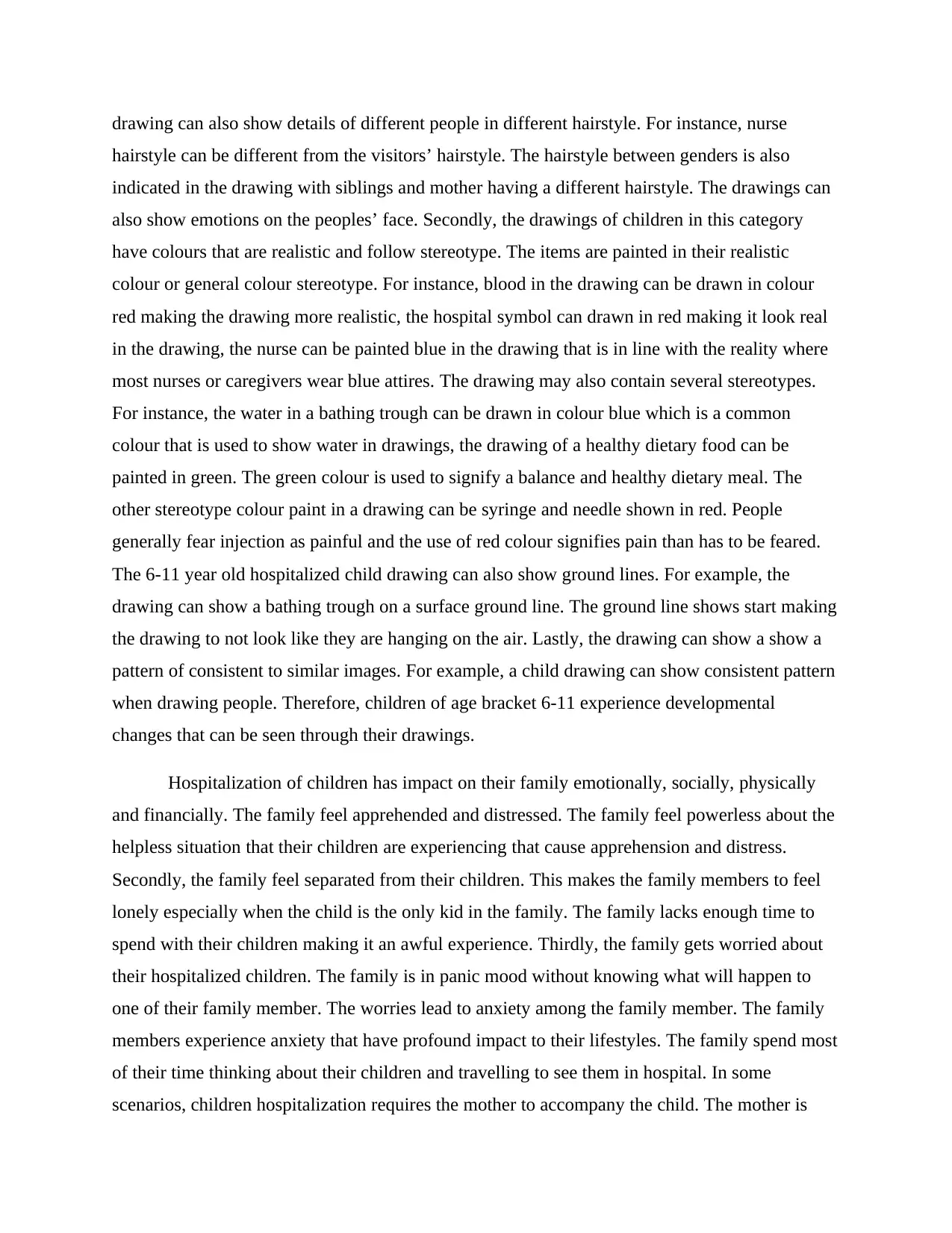
drawing can also show details of different people in different hairstyle. For instance, nurse
hairstyle can be different from the visitors’ hairstyle. The hairstyle between genders is also
indicated in the drawing with siblings and mother having a different hairstyle. The drawings can
also show emotions on the peoples’ face. Secondly, the drawings of children in this category
have colours that are realistic and follow stereotype. The items are painted in their realistic
colour or general colour stereotype. For instance, blood in the drawing can be drawn in colour
red making the drawing more realistic, the hospital symbol can drawn in red making it look real
in the drawing, the nurse can be painted blue in the drawing that is in line with the reality where
most nurses or caregivers wear blue attires. The drawing may also contain several stereotypes.
For instance, the water in a bathing trough can be drawn in colour blue which is a common
colour that is used to show water in drawings, the drawing of a healthy dietary food can be
painted in green. The green colour is used to signify a balance and healthy dietary meal. The
other stereotype colour paint in a drawing can be syringe and needle shown in red. People
generally fear injection as painful and the use of red colour signifies pain than has to be feared.
The 6-11 year old hospitalized child drawing can also show ground lines. For example, the
drawing can show a bathing trough on a surface ground line. The ground line shows start making
the drawing to not look like they are hanging on the air. Lastly, the drawing can show a show a
pattern of consistent to similar images. For example, a child drawing can show consistent pattern
when drawing people. Therefore, children of age bracket 6-11 experience developmental
changes that can be seen through their drawings.
Hospitalization of children has impact on their family emotionally, socially, physically
and financially. The family feel apprehended and distressed. The family feel powerless about the
helpless situation that their children are experiencing that cause apprehension and distress.
Secondly, the family feel separated from their children. This makes the family members to feel
lonely especially when the child is the only kid in the family. The family lacks enough time to
spend with their children making it an awful experience. Thirdly, the family gets worried about
their hospitalized children. The family is in panic mood without knowing what will happen to
one of their family member. The worries lead to anxiety among the family member. The family
members experience anxiety that have profound impact to their lifestyles. The family spend most
of their time thinking about their children and travelling to see them in hospital. In some
scenarios, children hospitalization requires the mother to accompany the child. The mother is
hairstyle can be different from the visitors’ hairstyle. The hairstyle between genders is also
indicated in the drawing with siblings and mother having a different hairstyle. The drawings can
also show emotions on the peoples’ face. Secondly, the drawings of children in this category
have colours that are realistic and follow stereotype. The items are painted in their realistic
colour or general colour stereotype. For instance, blood in the drawing can be drawn in colour
red making the drawing more realistic, the hospital symbol can drawn in red making it look real
in the drawing, the nurse can be painted blue in the drawing that is in line with the reality where
most nurses or caregivers wear blue attires. The drawing may also contain several stereotypes.
For instance, the water in a bathing trough can be drawn in colour blue which is a common
colour that is used to show water in drawings, the drawing of a healthy dietary food can be
painted in green. The green colour is used to signify a balance and healthy dietary meal. The
other stereotype colour paint in a drawing can be syringe and needle shown in red. People
generally fear injection as painful and the use of red colour signifies pain than has to be feared.
The 6-11 year old hospitalized child drawing can also show ground lines. For example, the
drawing can show a bathing trough on a surface ground line. The ground line shows start making
the drawing to not look like they are hanging on the air. Lastly, the drawing can show a show a
pattern of consistent to similar images. For example, a child drawing can show consistent pattern
when drawing people. Therefore, children of age bracket 6-11 experience developmental
changes that can be seen through their drawings.
Hospitalization of children has impact on their family emotionally, socially, physically
and financially. The family feel apprehended and distressed. The family feel powerless about the
helpless situation that their children are experiencing that cause apprehension and distress.
Secondly, the family feel separated from their children. This makes the family members to feel
lonely especially when the child is the only kid in the family. The family lacks enough time to
spend with their children making it an awful experience. Thirdly, the family gets worried about
their hospitalized children. The family is in panic mood without knowing what will happen to
one of their family member. The worries lead to anxiety among the family member. The family
members experience anxiety that have profound impact to their lifestyles. The family spend most
of their time thinking about their children and travelling to see them in hospital. In some
scenarios, children hospitalization requires the mother to accompany the child. The mother is
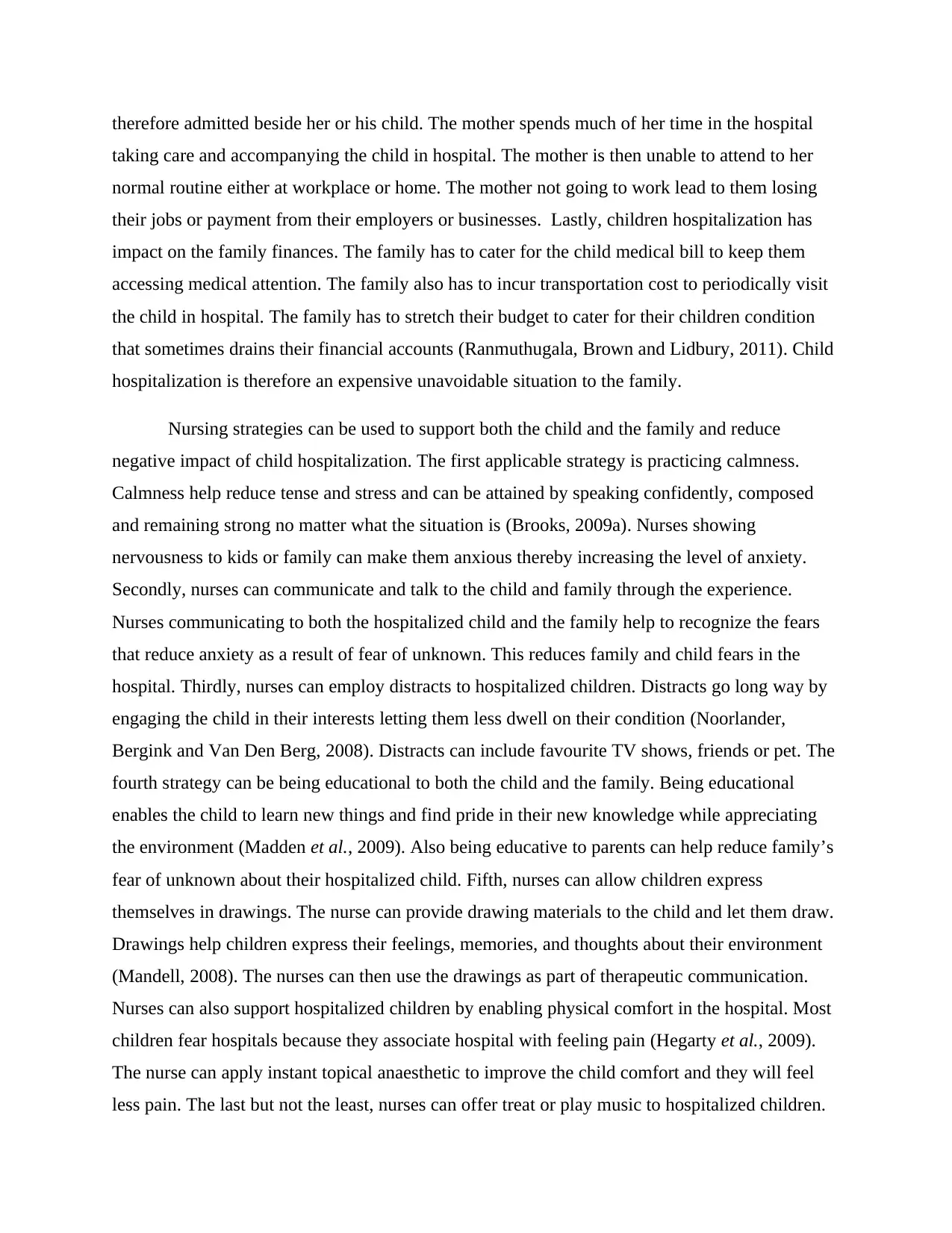
therefore admitted beside her or his child. The mother spends much of her time in the hospital
taking care and accompanying the child in hospital. The mother is then unable to attend to her
normal routine either at workplace or home. The mother not going to work lead to them losing
their jobs or payment from their employers or businesses. Lastly, children hospitalization has
impact on the family finances. The family has to cater for the child medical bill to keep them
accessing medical attention. The family also has to incur transportation cost to periodically visit
the child in hospital. The family has to stretch their budget to cater for their children condition
that sometimes drains their financial accounts (Ranmuthugala, Brown and Lidbury, 2011). Child
hospitalization is therefore an expensive unavoidable situation to the family.
Nursing strategies can be used to support both the child and the family and reduce
negative impact of child hospitalization. The first applicable strategy is practicing calmness.
Calmness help reduce tense and stress and can be attained by speaking confidently, composed
and remaining strong no matter what the situation is (Brooks, 2009a). Nurses showing
nervousness to kids or family can make them anxious thereby increasing the level of anxiety.
Secondly, nurses can communicate and talk to the child and family through the experience.
Nurses communicating to both the hospitalized child and the family help to recognize the fears
that reduce anxiety as a result of fear of unknown. This reduces family and child fears in the
hospital. Thirdly, nurses can employ distracts to hospitalized children. Distracts go long way by
engaging the child in their interests letting them less dwell on their condition (Noorlander,
Bergink and Van Den Berg, 2008). Distracts can include favourite TV shows, friends or pet. The
fourth strategy can be being educational to both the child and the family. Being educational
enables the child to learn new things and find pride in their new knowledge while appreciating
the environment (Madden et al., 2009). Also being educative to parents can help reduce family’s
fear of unknown about their hospitalized child. Fifth, nurses can allow children express
themselves in drawings. The nurse can provide drawing materials to the child and let them draw.
Drawings help children express their feelings, memories, and thoughts about their environment
(Mandell, 2008). The nurses can then use the drawings as part of therapeutic communication.
Nurses can also support hospitalized children by enabling physical comfort in the hospital. Most
children fear hospitals because they associate hospital with feeling pain (Hegarty et al., 2009).
The nurse can apply instant topical anaesthetic to improve the child comfort and they will feel
less pain. The last but not the least, nurses can offer treat or play music to hospitalized children.
taking care and accompanying the child in hospital. The mother is then unable to attend to her
normal routine either at workplace or home. The mother not going to work lead to them losing
their jobs or payment from their employers or businesses. Lastly, children hospitalization has
impact on the family finances. The family has to cater for the child medical bill to keep them
accessing medical attention. The family also has to incur transportation cost to periodically visit
the child in hospital. The family has to stretch their budget to cater for their children condition
that sometimes drains their financial accounts (Ranmuthugala, Brown and Lidbury, 2011). Child
hospitalization is therefore an expensive unavoidable situation to the family.
Nursing strategies can be used to support both the child and the family and reduce
negative impact of child hospitalization. The first applicable strategy is practicing calmness.
Calmness help reduce tense and stress and can be attained by speaking confidently, composed
and remaining strong no matter what the situation is (Brooks, 2009a). Nurses showing
nervousness to kids or family can make them anxious thereby increasing the level of anxiety.
Secondly, nurses can communicate and talk to the child and family through the experience.
Nurses communicating to both the hospitalized child and the family help to recognize the fears
that reduce anxiety as a result of fear of unknown. This reduces family and child fears in the
hospital. Thirdly, nurses can employ distracts to hospitalized children. Distracts go long way by
engaging the child in their interests letting them less dwell on their condition (Noorlander,
Bergink and Van Den Berg, 2008). Distracts can include favourite TV shows, friends or pet. The
fourth strategy can be being educational to both the child and the family. Being educational
enables the child to learn new things and find pride in their new knowledge while appreciating
the environment (Madden et al., 2009). Also being educative to parents can help reduce family’s
fear of unknown about their hospitalized child. Fifth, nurses can allow children express
themselves in drawings. The nurse can provide drawing materials to the child and let them draw.
Drawings help children express their feelings, memories, and thoughts about their environment
(Mandell, 2008). The nurses can then use the drawings as part of therapeutic communication.
Nurses can also support hospitalized children by enabling physical comfort in the hospital. Most
children fear hospitals because they associate hospital with feeling pain (Hegarty et al., 2009).
The nurse can apply instant topical anaesthetic to improve the child comfort and they will feel
less pain. The last but not the least, nurses can offer treat or play music to hospitalized children.
⊘ This is a preview!⊘
Do you want full access?
Subscribe today to unlock all pages.

Trusted by 1+ million students worldwide
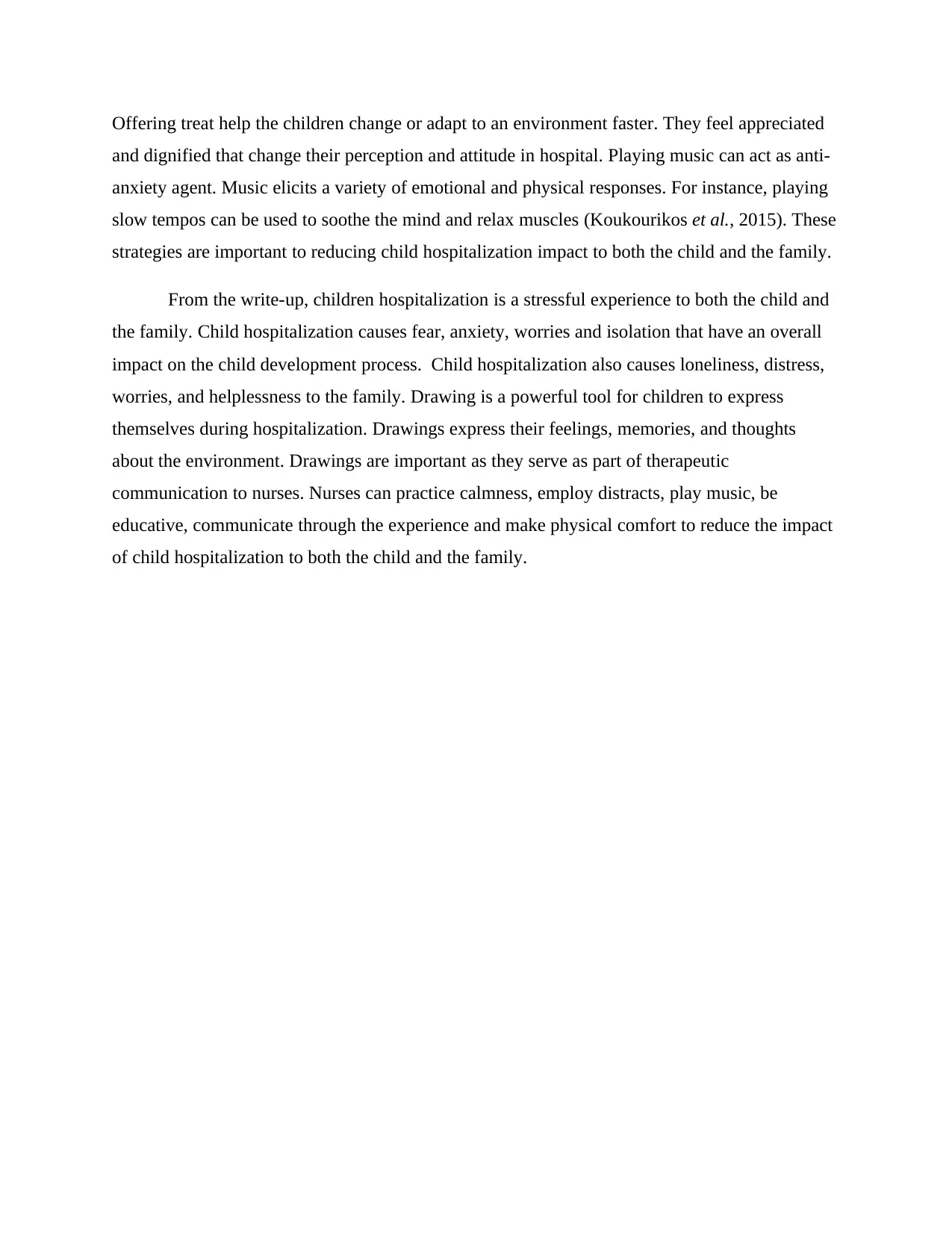
Offering treat help the children change or adapt to an environment faster. They feel appreciated
and dignified that change their perception and attitude in hospital. Playing music can act as anti-
anxiety agent. Music elicits a variety of emotional and physical responses. For instance, playing
slow tempos can be used to soothe the mind and relax muscles (Koukourikos et al., 2015). These
strategies are important to reducing child hospitalization impact to both the child and the family.
From the write-up, children hospitalization is a stressful experience to both the child and
the family. Child hospitalization causes fear, anxiety, worries and isolation that have an overall
impact on the child development process. Child hospitalization also causes loneliness, distress,
worries, and helplessness to the family. Drawing is a powerful tool for children to express
themselves during hospitalization. Drawings express their feelings, memories, and thoughts
about the environment. Drawings are important as they serve as part of therapeutic
communication to nurses. Nurses can practice calmness, employ distracts, play music, be
educative, communicate through the experience and make physical comfort to reduce the impact
of child hospitalization to both the child and the family.
and dignified that change their perception and attitude in hospital. Playing music can act as anti-
anxiety agent. Music elicits a variety of emotional and physical responses. For instance, playing
slow tempos can be used to soothe the mind and relax muscles (Koukourikos et al., 2015). These
strategies are important to reducing child hospitalization impact to both the child and the family.
From the write-up, children hospitalization is a stressful experience to both the child and
the family. Child hospitalization causes fear, anxiety, worries and isolation that have an overall
impact on the child development process. Child hospitalization also causes loneliness, distress,
worries, and helplessness to the family. Drawing is a powerful tool for children to express
themselves during hospitalization. Drawings express their feelings, memories, and thoughts
about the environment. Drawings are important as they serve as part of therapeutic
communication to nurses. Nurses can practice calmness, employ distracts, play music, be
educative, communicate through the experience and make physical comfort to reduce the impact
of child hospitalization to both the child and the family.
Paraphrase This Document
Need a fresh take? Get an instant paraphrase of this document with our AI Paraphraser
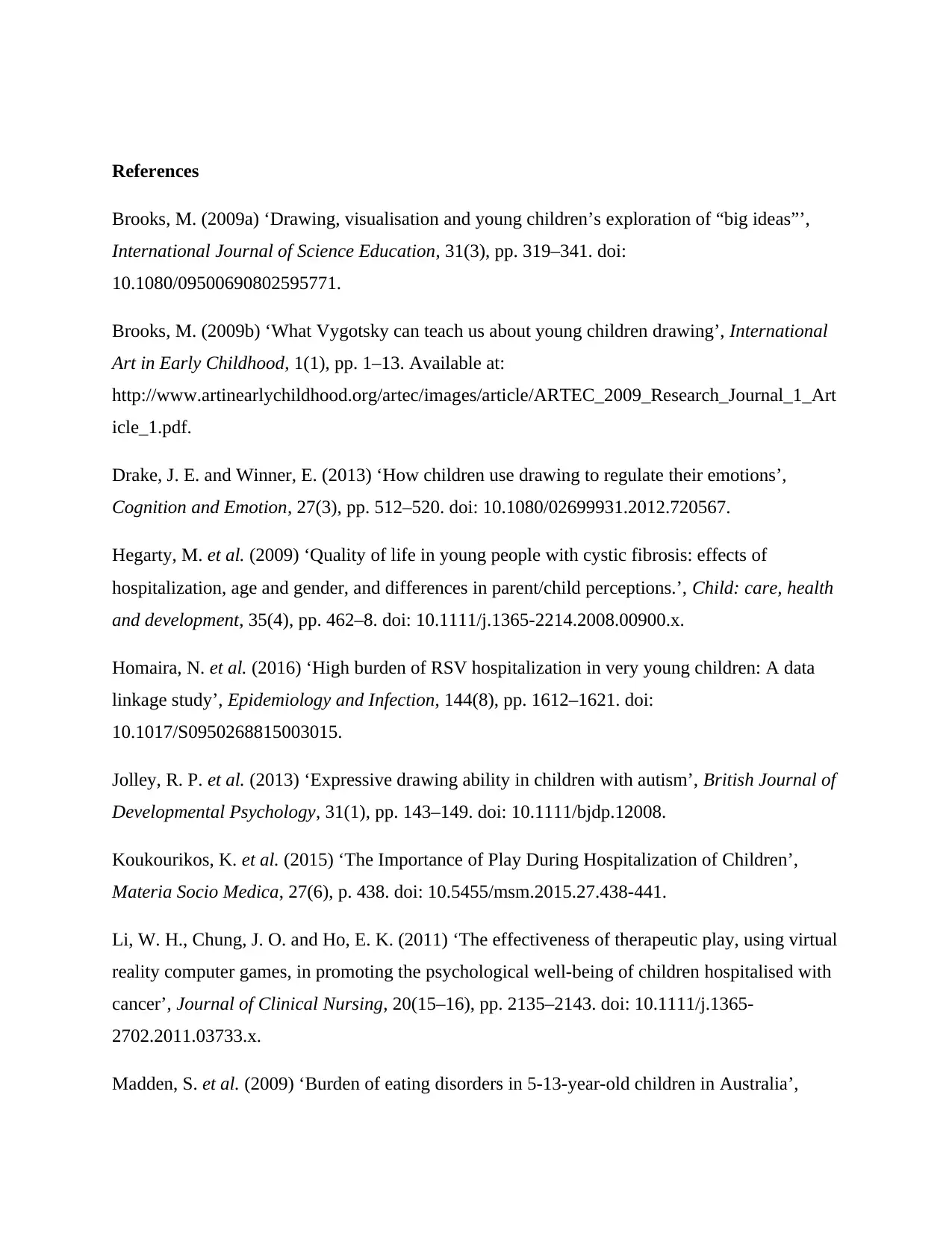
References
Brooks, M. (2009a) ‘Drawing, visualisation and young children’s exploration of “big ideas”’,
International Journal of Science Education, 31(3), pp. 319–341. doi:
10.1080/09500690802595771.
Brooks, M. (2009b) ‘What Vygotsky can teach us about young children drawing’, International
Art in Early Childhood, 1(1), pp. 1–13. Available at:
http://www.artinearlychildhood.org/artec/images/article/ARTEC_2009_Research_Journal_1_Art
icle_1.pdf.
Drake, J. E. and Winner, E. (2013) ‘How children use drawing to regulate their emotions’,
Cognition and Emotion, 27(3), pp. 512–520. doi: 10.1080/02699931.2012.720567.
Hegarty, M. et al. (2009) ‘Quality of life in young people with cystic fibrosis: effects of
hospitalization, age and gender, and differences in parent/child perceptions.’, Child: care, health
and development, 35(4), pp. 462–8. doi: 10.1111/j.1365-2214.2008.00900.x.
Homaira, N. et al. (2016) ‘High burden of RSV hospitalization in very young children: A data
linkage study’, Epidemiology and Infection, 144(8), pp. 1612–1621. doi:
10.1017/S0950268815003015.
Jolley, R. P. et al. (2013) ‘Expressive drawing ability in children with autism’, British Journal of
Developmental Psychology, 31(1), pp. 143–149. doi: 10.1111/bjdp.12008.
Koukourikos, K. et al. (2015) ‘The Importance of Play During Hospitalization of Children’,
Materia Socio Medica, 27(6), p. 438. doi: 10.5455/msm.2015.27.438-441.
Li, W. H., Chung, J. O. and Ho, E. K. (2011) ‘The effectiveness of therapeutic play, using virtual
reality computer games, in promoting the psychological well-being of children hospitalised with
cancer’, Journal of Clinical Nursing, 20(15–16), pp. 2135–2143. doi: 10.1111/j.1365-
2702.2011.03733.x.
Madden, S. et al. (2009) ‘Burden of eating disorders in 5-13-year-old children in Australia’,
Brooks, M. (2009a) ‘Drawing, visualisation and young children’s exploration of “big ideas”’,
International Journal of Science Education, 31(3), pp. 319–341. doi:
10.1080/09500690802595771.
Brooks, M. (2009b) ‘What Vygotsky can teach us about young children drawing’, International
Art in Early Childhood, 1(1), pp. 1–13. Available at:
http://www.artinearlychildhood.org/artec/images/article/ARTEC_2009_Research_Journal_1_Art
icle_1.pdf.
Drake, J. E. and Winner, E. (2013) ‘How children use drawing to regulate their emotions’,
Cognition and Emotion, 27(3), pp. 512–520. doi: 10.1080/02699931.2012.720567.
Hegarty, M. et al. (2009) ‘Quality of life in young people with cystic fibrosis: effects of
hospitalization, age and gender, and differences in parent/child perceptions.’, Child: care, health
and development, 35(4), pp. 462–8. doi: 10.1111/j.1365-2214.2008.00900.x.
Homaira, N. et al. (2016) ‘High burden of RSV hospitalization in very young children: A data
linkage study’, Epidemiology and Infection, 144(8), pp. 1612–1621. doi:
10.1017/S0950268815003015.
Jolley, R. P. et al. (2013) ‘Expressive drawing ability in children with autism’, British Journal of
Developmental Psychology, 31(1), pp. 143–149. doi: 10.1111/bjdp.12008.
Koukourikos, K. et al. (2015) ‘The Importance of Play During Hospitalization of Children’,
Materia Socio Medica, 27(6), p. 438. doi: 10.5455/msm.2015.27.438-441.
Li, W. H., Chung, J. O. and Ho, E. K. (2011) ‘The effectiveness of therapeutic play, using virtual
reality computer games, in promoting the psychological well-being of children hospitalised with
cancer’, Journal of Clinical Nursing, 20(15–16), pp. 2135–2143. doi: 10.1111/j.1365-
2702.2011.03733.x.
Madden, S. et al. (2009) ‘Burden of eating disorders in 5-13-year-old children in Australia’,
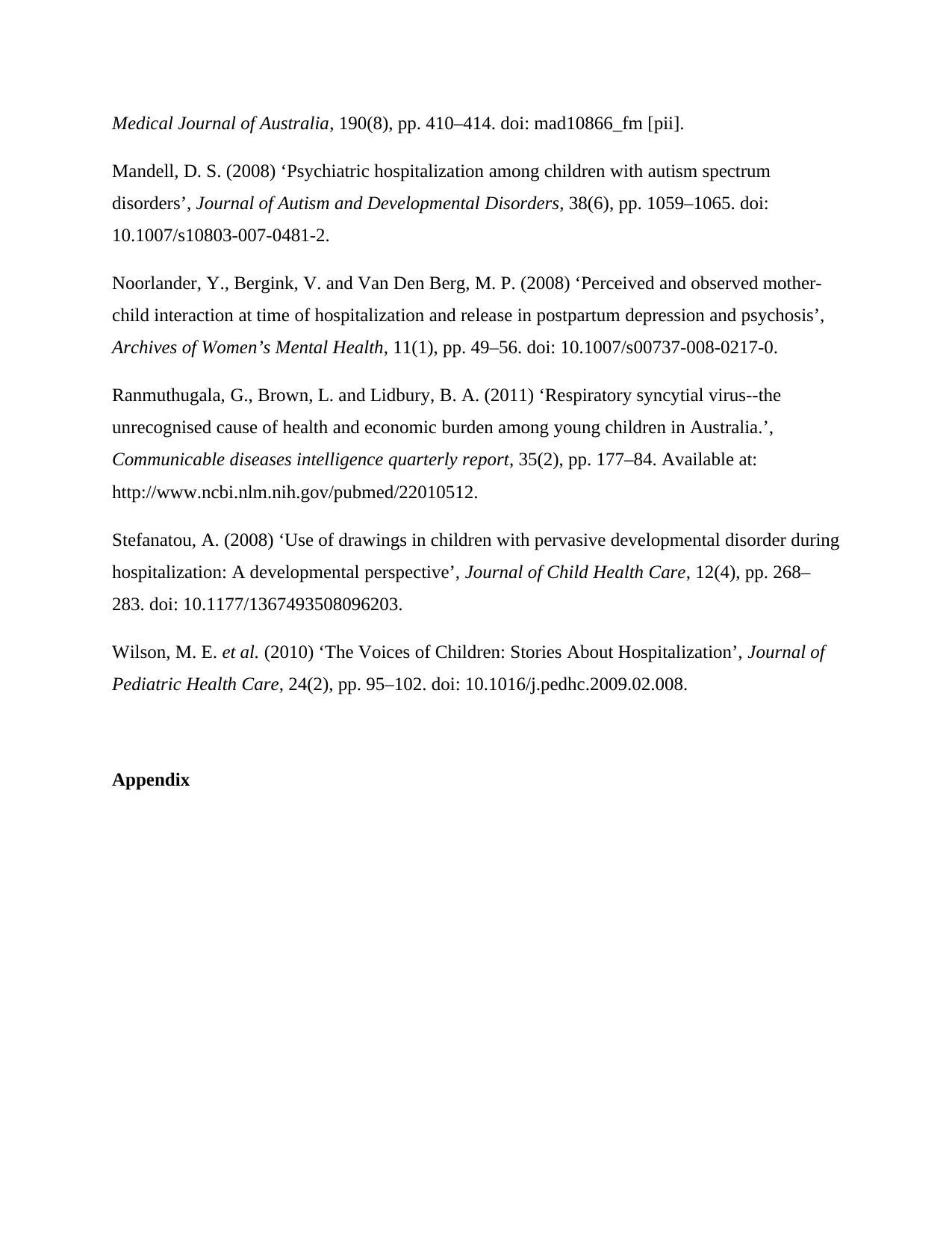
Medical Journal of Australia, 190(8), pp. 410–414. doi: mad10866_fm [pii].
Mandell, D. S. (2008) ‘Psychiatric hospitalization among children with autism spectrum
disorders’, Journal of Autism and Developmental Disorders, 38(6), pp. 1059–1065. doi:
10.1007/s10803-007-0481-2.
Noorlander, Y., Bergink, V. and Van Den Berg, M. P. (2008) ‘Perceived and observed mother-
child interaction at time of hospitalization and release in postpartum depression and psychosis’,
Archives of Women’s Mental Health, 11(1), pp. 49–56. doi: 10.1007/s00737-008-0217-0.
Ranmuthugala, G., Brown, L. and Lidbury, B. A. (2011) ‘Respiratory syncytial virus--the
unrecognised cause of health and economic burden among young children in Australia.’,
Communicable diseases intelligence quarterly report, 35(2), pp. 177–84. Available at:
http://www.ncbi.nlm.nih.gov/pubmed/22010512.
Stefanatou, A. (2008) ‘Use of drawings in children with pervasive developmental disorder during
hospitalization: A developmental perspective’, Journal of Child Health Care, 12(4), pp. 268–
283. doi: 10.1177/1367493508096203.
Wilson, M. E. et al. (2010) ‘The Voices of Children: Stories About Hospitalization’, Journal of
Pediatric Health Care, 24(2), pp. 95–102. doi: 10.1016/j.pedhc.2009.02.008.
Appendix
Mandell, D. S. (2008) ‘Psychiatric hospitalization among children with autism spectrum
disorders’, Journal of Autism and Developmental Disorders, 38(6), pp. 1059–1065. doi:
10.1007/s10803-007-0481-2.
Noorlander, Y., Bergink, V. and Van Den Berg, M. P. (2008) ‘Perceived and observed mother-
child interaction at time of hospitalization and release in postpartum depression and psychosis’,
Archives of Women’s Mental Health, 11(1), pp. 49–56. doi: 10.1007/s00737-008-0217-0.
Ranmuthugala, G., Brown, L. and Lidbury, B. A. (2011) ‘Respiratory syncytial virus--the
unrecognised cause of health and economic burden among young children in Australia.’,
Communicable diseases intelligence quarterly report, 35(2), pp. 177–84. Available at:
http://www.ncbi.nlm.nih.gov/pubmed/22010512.
Stefanatou, A. (2008) ‘Use of drawings in children with pervasive developmental disorder during
hospitalization: A developmental perspective’, Journal of Child Health Care, 12(4), pp. 268–
283. doi: 10.1177/1367493508096203.
Wilson, M. E. et al. (2010) ‘The Voices of Children: Stories About Hospitalization’, Journal of
Pediatric Health Care, 24(2), pp. 95–102. doi: 10.1016/j.pedhc.2009.02.008.
Appendix
⊘ This is a preview!⊘
Do you want full access?
Subscribe today to unlock all pages.

Trusted by 1+ million students worldwide
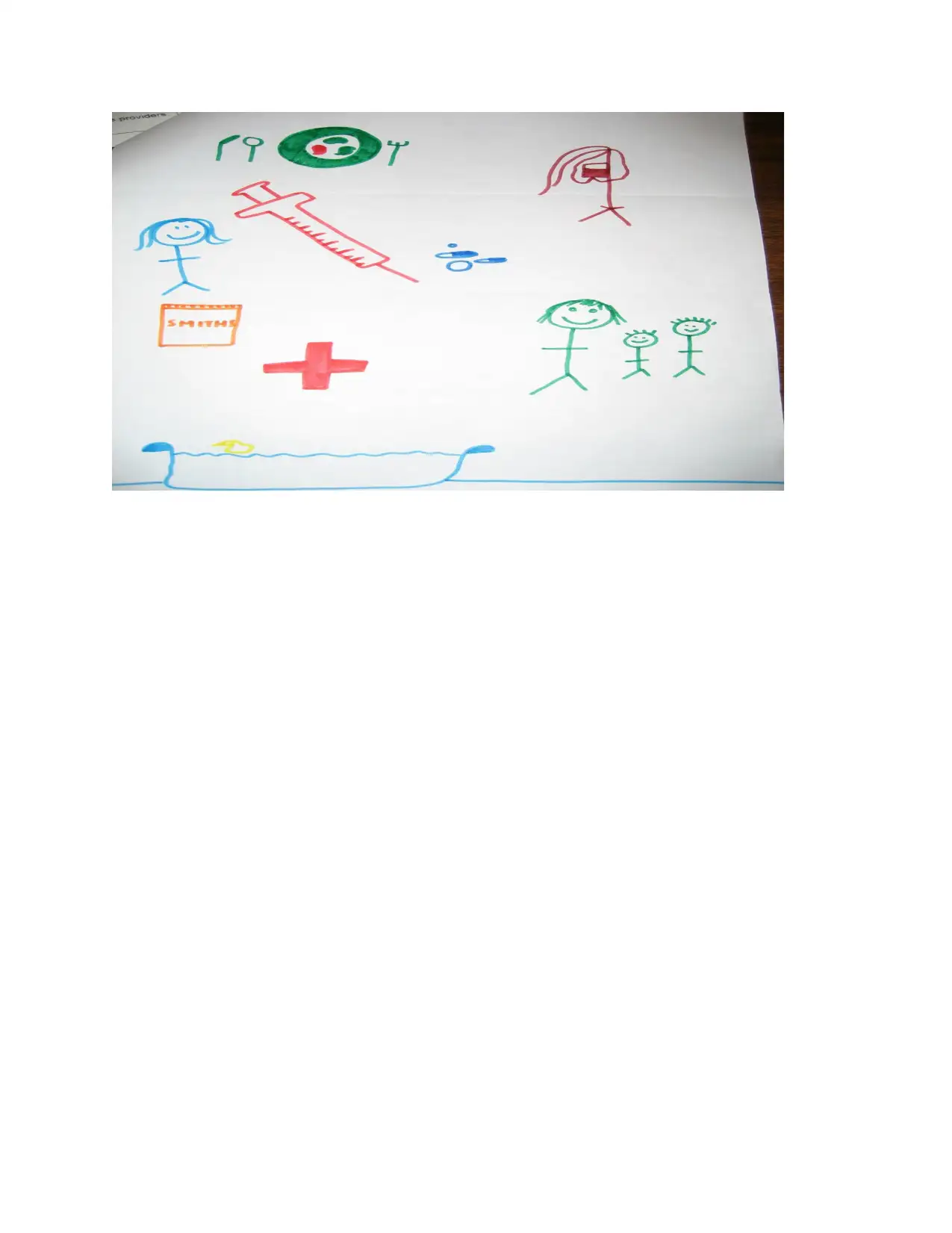
1 out of 10
Your All-in-One AI-Powered Toolkit for Academic Success.
+13062052269
info@desklib.com
Available 24*7 on WhatsApp / Email
![[object Object]](/_next/static/media/star-bottom.7253800d.svg)
Unlock your academic potential
Copyright © 2020–2025 A2Z Services. All Rights Reserved. Developed and managed by ZUCOL.